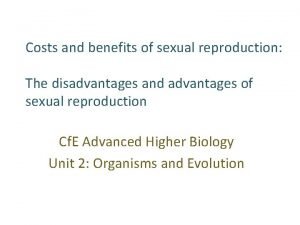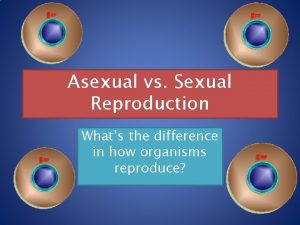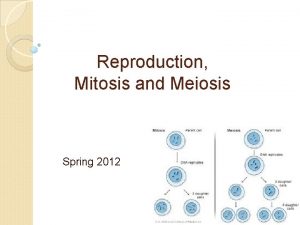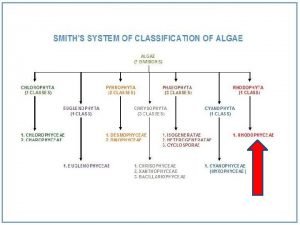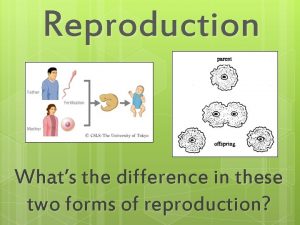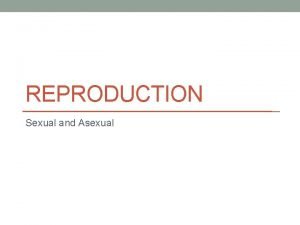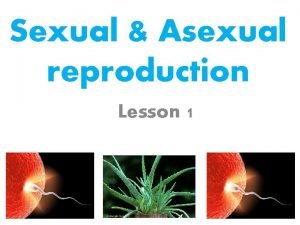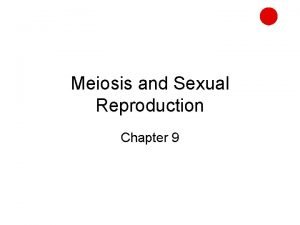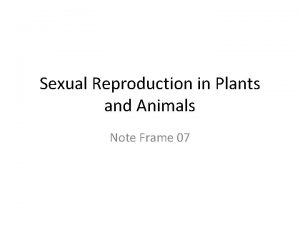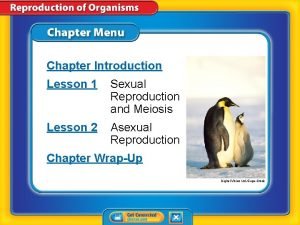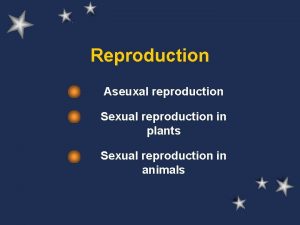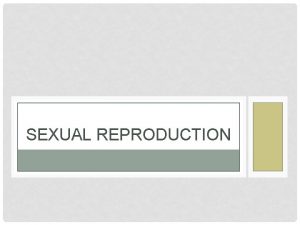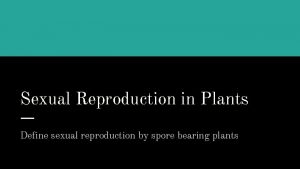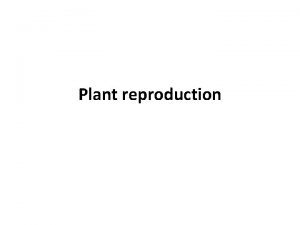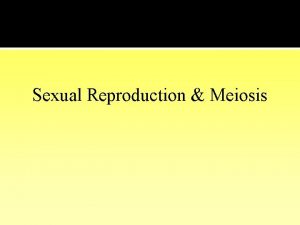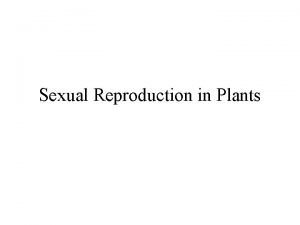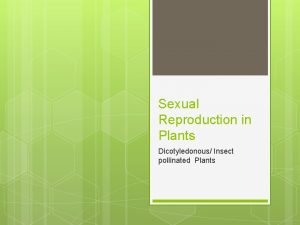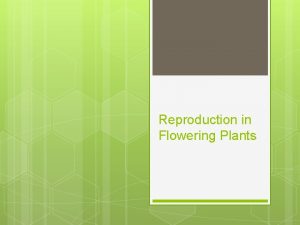Reproduction Aseuxal reproduction Sexual reproduction in plants Sexual

















- Slides: 17

Reproduction Aseuxal reproduction Sexual reproduction in plants Sexual reproduction in animals

Asexual reproduction l Binary fission – Unicellular organisms such as Amoeba and Paramecium divide into two by the process binary fission. l Budding – The unicellular fungus Yeast undergoes budding for asexual reproduction. However, budding is different from binaryfission in that the new part produced is smaller in size than the parent.

Asexual reproduction in Angiosperms(Flowering plants) l l Bulb – e. g. onion, daffodil – Bulbs are modified shortened, vertical stems surrounded by fleshy scale leaves with base swollen with food stores. Corms – e. g. Gladiolus, Crocus – Corms are short, erect, swollen underground stems and contain scale leaves but no fleshy leaves. Rhizomes – e. g. ginger, lotus, iris, mint – Rhizomes contain horizontally growing underground stems and bear nodes, scale leaves, adventitious roots and axillary buds. Tuber – e. g. potatoes, arrowheads – Tubers are swollen ends of underground stems with numerous axillary buds in scale leaf scars.

Comparison of the advantages and disadvantages of vegetative propagation

Male reproduction system l The male reproduction system of human consists of two testes, sex glands, urethra and penis.

Female reproduction system l The female reproduction system of human consists of two ovaries,

Sexual maturity in men and women l l The sex organs only begin to produce gametes and large amount of sex hormones at time of sexual maturity which is known as puberty. Puberty usually begin between the age of 12 and 14. It occurs earlier in girls than in boys. The sex hormones cause the development of secondary sexual characteristics which mark out the male from female. ( I ) Secondary sexual characteristics in men: – Hairs grow on face, under the armpits and around the base of the penis. – Shoulders broaden and muscles rapidly develop. – Larynx enlarges and voice becomes lower and coarse. ( II ) Secondary sexual characteristics in women: – Hairs grow under the armpits and around the vulva. – Hip girdles broaden. – Breasts (mammary glands) develop. – Menstruation starts.

Reproductive cycle l Ovulation – For every 28 days only one ovum is released from one of the ovaries of the matured woman. This process is called Ovulation. l Thickening of uterine lining – At the same time, the uterine lining is thickening by increasing the cell division and blood supply, to prepare for the fertilized egg to implant in.

Reproductive cycle l Menstruation – The thickened uterine lining gradually breaks down when there is no fertilization occu

Reproductive cycle l Menstrual cycle

Transfer of semen and fertilization l l During sexual intercourse, the dilation of the arterioles in penis increases the turgidity of its erectile tissues. The erect penis is inserted into the vagina of the female. Process – The muscular contraction of the epididymis and sperm duct cause the ejaculation of about 5 ml of semen through the urethra into vagina. – Each ejaculation may introduce about 300 -500 millions of sperms. Such large number of sperms is produced to increase the chance of fertilization. The sperms remain alive from 1 to 3 days in the female reproductive tract. – The sperms use their tails to swim from the vagina through the cervix and the uterus to the oviduct. – Their environment is also assisted by the muscular contraction of the uterus and oviduct. – Only the nucleus of one sperm can enter the ovum to fuse with her nucleus to form a diploid Zygote. It is called Fertilization. Once fertilization occurs, other sperms cannot pass through the egg membrane of the ovum.

Mammalian embryo l Implantation – A zygote formed by fusion of the egg and sperm moves slowly down the oviduct to the

Mammalian embryo l l l Amnion covers the embryo and secretes amniotic fluid. Amniotic fluid acts as a shock absorber, protects the embryo from mechanical shock, prevents the embryo from becoming desiccated and allows it some freedom of movement. Placenta connect the embryo to the wall of the uterus in order to supply the nutrients and oxygen to the embryo and remove the wastes (CO 2, urea). Umbilical cord transports the blood between the embryo and the placenta for exchange of food and wastes. Development of embryo to form a foetus is called gestation.

Parturition l l l Before birth of the foetus, the position of the foetus alters so that it lies head downward near the opening of the cervix. When birth the muscles in the wall of uterus contract rhythmically to push the baby out of mother through the cervix. After birth the baby is still attached to the placenta by the umbilical cord. The umbilical cord is tied and cut that the scar becomes the navel. The placenta detaches from the uterine wall to become afterbirth.

Birth control Contraception methods l Natural method – Women should have intercourse during safe period l Contraceptive pills – Combined pill ¡Vcontains oestrogen and progesterone – Mini-pill ¡Vcontains only progesterone

Birth control l Barrier method – Condom – Diaphragm

Birth control l Surgical method sterilization – A permanent method of birth control and Vesectomy Tubal ligation l Intrauterine devices IUD l l
 A sexual reproduction in plants
A sexual reproduction in plants Hare lynx
Hare lynx Asexual vs sexual venn diagram
Asexual vs sexual venn diagram Binary fission in bacteria
Binary fission in bacteria Disadvantage of sexual reproduction
Disadvantage of sexual reproduction Requires two parents
Requires two parents Plants and animals reproduction venn diagram
Plants and animals reproduction venn diagram Chapter 20 sexual reproduction in animals packet answers
Chapter 20 sexual reproduction in animals packet answers Whats asexual reproduction
Whats asexual reproduction Definition of mitosis
Definition of mitosis Red algae is oogamous
Red algae is oogamous Whats sexual reproduction
Whats sexual reproduction Sexual reproduction
Sexual reproduction Significance of sexual reproduction
Significance of sexual reproduction Chapter 9
Chapter 9 Asexual reproduction
Asexual reproduction Where does cactus store water
Where does cactus store water Connecting the concepts sexual reproduction
Connecting the concepts sexual reproduction




